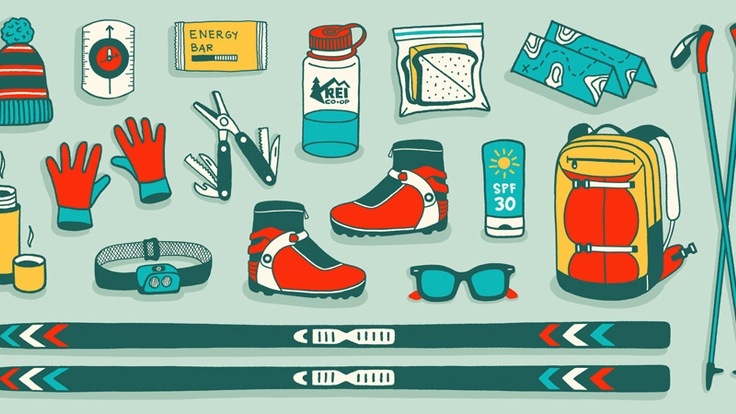Prepping for a day of cross-country skiing in a developed trail system is a little like packing for a day hike. You don't need a ton of gear, but you do need to prepare for contingencies. To determine your needs, think about the details of your day. If your destination requires a very long ski or the forecast is stormy, then you'll need more clothing, gear and food.
In addition to the resources you can find on REI.com, we can help prepare you for an outdoor adventure at REI Co-op stores nationwide, where you can ask questions, join local outings and classes, buy essentials, or rent gear. You can also ask questions and order gear by calling 1-800-426-4840; or you can send us an email or live chat with us.
If you're planning a trip beyond developed areas and groomed trail systems, where avalanches might be a concern or you will be sleeping overnight, you'll need many more items. Consult our Backcountry Skiing Checklist and Winter Camping Checklist to find gear options for those types of trips.
What to Bring Cross-Country Skiing
- Small pack
- Weather-appropriate clothing
- Skis/boots/poles
- Food and water
- The Ten Essentials
How to Use This Cross-Country Skiing Checklist
Use this handy Cross-Country Skiing checklist to make sure you don't forget anything important. Here are some notes on how to use this list:
- This list is deliberately comprehensive—and just a starting point. Adapt it to meet your specific needs (which might also include additional items).
- Items that are part of the Ten Essentials systems are marked by an asterisk (*). The exact items you take can be tailored to your trip based on weather, difficulty, duration and distance from help. To learn more, read the Ten Essentials.
- Print out the PDF version for easy use at home.
Printer-Friendly Version (PDF)
Skiing Gear
Read How to Choose Cross-Country Ski Gear for tips on what you need. (At many REI Co-op stores, you can rent these items in a ski package.)
Tools
Pack size will vary based how much you bring, as well as the bulkiness of the clothing you bring. A hiking daypack can work just fine; a ski-specific pack will simply have nice touches like insulated compartments or special storage features for winter gear.
- Knife or multi-tool *
- Repair supplies *
(a few strips of duct tape can come in handy)
Clothing
Read What to Wear Cross-Country Skiing for an overview of clothing tactics. Check the forecast to make sure you're prepared for worsening conditions. And always prepare for an unplanned night out by packing extra clothes
* beyond what you wear that day.- Socks (synthetic or wool)
- Gloves or mittens
- Warm hat
Additional options for rest stops, and added warmth and coverage:
- Neck gaiter
- Insulated mittens or gloves
- Hand and foot warmers
Food & Water
Pack snacks like energy bars and nuts that you can eat easily on the trail. Bring plenty of both food and water, too, because cross-country skiing burns a lot of calories and cold weather dehydrates you more quickly. Learn more about choosing energy food and how much you drink.
- Water bottle(s) or reservoir *
(insulate the tube and bite valve if possible)
- Trail snacks
- Lunch
Navigation
Because a lot of groomed areas post trail maps on signs throughout the trail system and provide paper maps, many skiers choose to rely solely on those items. Navigation *, though, is one of the Ten Essentials, so it's always wise to bring these navigation essentials with you to the trailhead.
First Aid & Emergency Gear
- First-aid kit or first-aid supplies *
(see
First-Aid Checklist)
- Whistle
- Lighter/matches (in waterproof container) *
- Fire starter (for emergency survival fire) *
- Emergency shelter *
- Two itineraries: 1 left with friend + 1 under car seat
- Satellite messenger/personal locator beacon (optional)
Health & Hygiene
- Toilet paper/wipes and sealable bag (to pack it out)
- Prescription medications (if needed)
Sun protection *:
- Sunglasses *
(+
sunglasses straps)
- Sunscreen *
Personal Items
- Credit card and/or cash
- ID
- Trail pass
- Cellphone (+ portable charger)
- Watch
* These items are part of the Ten Essentials systems. The exact items you take for each system can be tailored to your trip based on considerations such as weather, difficulty, duration and distance from help. To learn more, see our article on the Ten Essentials.
